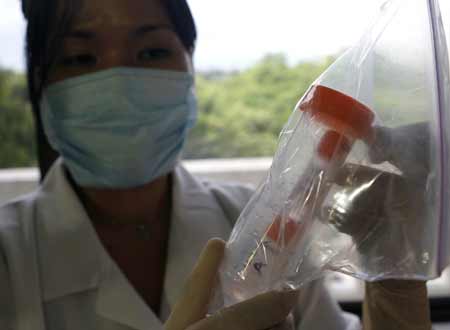|

|
|
A laboratory technician shows a testing kit from the U.S. Center Disease Control (CDC) on how to determine the presence of the new H1N1 flu virus, formerly referred to as the swine flu, inside the laboratory of the Philippine Research Institute for Tropical Medicine at Muntinlupa city, south of Manila, May 13, 2009. [Xinhua Reuters Photo] |
The confirmed A/H1N1 flu cases continue to rise worldwide on Wednesday as Belgium reported its first known case, bringing the tally of affected countries to 34.
A 28-year-old patient, who is from the northern Belgian city of Ghent, fell ill Monday after his return from a two-week trip in New York and Chicago in the United States, said Belgian Health Minister Laurette Onkelinx.
This made Belgium the 16th country in Europe and the 34th country in the world which was affected by the disease.
Elsewhere, Mexico's Health Minister Jose Angel Cordova Villalobos said the confirmed death toll from the A/H1N1 flu has risen to 60, and the total confirmed cases were now 2,386 at the Wednesday morning press conference.
Cordova said 56 of the 60 confirmed deaths were infected before April 23, when the Mexican government declared an alert, indicating the virus is not so rampant as it first attacked the country.
In the United States, the number of confirmed A/ H1N1 cases has risen to 3,352 in 45 U.S. states, with three deaths, the U.S. Centers for Disease Control and Prevention (CDC) reported Wednesday.
The country witnessed an increase of over 300 in confirmed cases in a single day as 3,009 known cases were reported a day earlier.
The increase in the number of confirmed cases showed that the ongoing outbreak of the novel influenza continues to expand in the United States. CDC officials have said they expect the A/H1N1 flu to spread to all 50 states, to cause severe disease and some deaths.
Meanwhile, confirmed cases in Canada rose to 389 Wednesday, with 31 new cases added during the day, according to the latest figures from the Public Health Agency of Canada (PHAC).
The PHAC said most Canadian cases are mild, with 11 cases having been hospitalized and one death reported up to now.
So far, over 6,000 confirmed cases have been discovered across the world, according to WHO and governments data.
It is still unknown how the H1N1 virus behaves, and the clinical spectrum of the disease which it can cause is yet to be fully understood, Julie Hall, an epidemiologist of the WHO told Singaporean TV broadcaster Channel News Asia.
"We're calling on all governments to be vigilant, to try and detect the virus as quickly as possible and to try to delay the spread of the virus," Hall was quoted as saying in the report.
In an effort to jointly tackle the threat, representatives of the European Union and the Latin American nations meet in Prague Wednesday.
The EU member states and the Latin American countries from the Rio Group will cooperate in the fight against the spread of the new H1N1 flu and to overcome its social and economic impact, the countries' foreign ministers pledged in a joint statement at the meeting.
The ministers said at the EU-Rio Group summit, organized by the Czech presidency of the European Union, that they fully share the international concern about the disease and they called for efforts to closely monitor the situation.
Experts have warned against a possible pandemic caused by the H1N1 virus that combines the swine, bird and human flu viruses.
(Xinhua News Agency May 14, 2009)